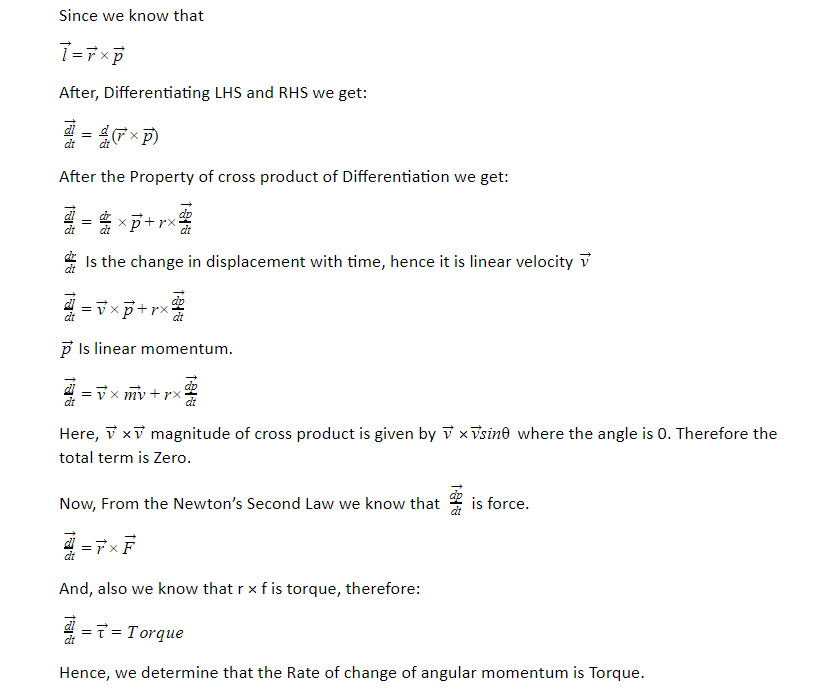Conservation of angular momentum is a physical property of a spinning system in which the spin remains constant until it is acted upon by an external torque; in other words, the rotational speed remains constant as long as the net torque is zero.
The velocity of rotation of something around an axis is known as angular momentum, often known as spin. Gyroscopes are simple devices that use angular momentum conservation to stabilize, control, and measure rotating movement in a variety of systems. The law of conservation of angular momentum explains why a spinning top or a toy gyroscope stays upright as it spins rather than succumbing to gravity and toppling over.
Conservation of Angular Momentum
The conservation of angular momentum is one of four fundamental conservation principles in physics that declare that a specific attribute of a physical system remains constant over time. Conservation of linear momentum, conservation of energy, and conservation of electric charge are the other three exact conservation rules.
When the wheels on a bicycle spin up to speed, they act like gyroscopes, making it easier for the bicycle to stay upright and making it more difficult for anything to disrupt its motion. The ability of a figure skater to increase his spin by pushing his arms closer to his body, as well as the rise in the spin of an orbiting planet as it comes closer to the sun, are both examples of angular momentum conservation at work.
Angular momentum (also known as moment of momentum or rotational momentum) is the rotational analog of linear momentum in physics. As it is a conserved quantity, the total angular momentum of a closed system remains constant. It is a significant quantity in physics. Both the direction and the magnitude of angular momentum are conserved.
Conservation of angular momentum is responsible for the useful properties of motorcycles, Frisbees, and rifled bullets. Hurricanes have spirals and neutron stars have fast rotating rates because of conservation of angular momentum. In general, conservation confines a system’s possible motion but does not determine it.
Formula for Conservation of Angular Momentum
It is the rotational equivalent of linear momentum, symbolized by the letter l, and angular momentum of a particle in rotation is defined as:
l=r×p
Hence in the case of angular momentum the magnitude is given by:
l=rpsinθ
If we have an extended object, such as our earth, the angular momentum is calculated by multiplying the moment of inertia (how much mass is in motion in the object and how far it is from the center) by the angular velocity.
Angular Momentum
Angular momentum is a massive Quantity; each composite system’s total angular momentum is equal to the sum of its constituent elements’ angular momenta. Total angular momentum is the volume integral of angular momentum density (i.e. angular momentum per unit volume in the limit as volume shrinks to zero) throughout the entire body for a continuous rigid body or a fluid.
In the same way that linear momentum is conserved in the absence of an external force, angular momentum is conserved in the absence of an external torque.
Torque
Torque, like force, is defined as the rate of change of angular momentum. The sum of all internal torques in any system is always Zero; in other words, the net external torque on any system is always equal to the total torque on the system.
The rotating equivalent of linear force is termed as torque. Depending on the subject of study, it is also known as the moment, moment of force, rotating force, or turning effect. It denotes a force’s ability to cause a change in the rotational motion of a body. Archimedes’ study of the use of levers gave birth to the concept. A torque is a twist of an item around a given axis, similar to how a linear force is a push or a pull.
Relationship between Torque and Angular Momentum
Conclusion
In this article we are studied about angular momentum and conservation of angular momentum. The net angular momentum of a system remains constant if no net external torque applied on it. The conservation of angular momentum is described by this statement. It’s the third of the major conservation rules in mechanics that you’ll come upon (along with the conservation of energy and of linear momentum).The conservation of linear momentum differs from the conservation of angular momentum in one important way. The overall mass of a system of particles cannot change.
 Profile
Profile Settings
Settings Refer your friends
Refer your friends Sign out
Sign out







